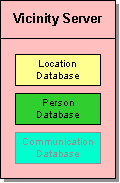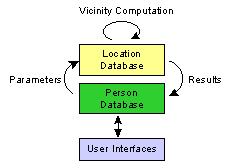| Vicinity Server - Architecture |
Vicinity servers maintain backward references for all hypertext references in order to provide symmetric visibility. References and backward references to documents on the same server (core links) are maintained easily and efficiently in the local database. Information about links to documents on other web servers (surface links) is exchanged between vicinity servers. This is done rarely so that the generated traffic is only a small fraction of the HTTP traffic between Web clients and Web servers. Location databases of all vicinity servers resemble the links the fraction of the Web covered by Cobrow. The database of persons keeps information about users, real and virtual ones. It essentially contains names, addresses, pages visited, icons, preferences, etc.
User interfaces get the computed vicinity from the person database. But the location database can also be accessed in case a user interface displays not only people, but also information about documents, such as the link structure of a Web site. |
 A vicinity server essentially maintains 2 databases, a database of
locations and a database of persons. The location database (also referred to as link
database) reflects the document and link structure of the augmented Web server(s).
A vicinity server essentially maintains 2 databases, a database of
locations and a database of persons. The location database (also referred to as link
database) reflects the document and link structure of the augmented Web server(s).  The main task of the vicinity server is the computation of the vicinity for
each user. The computation is almost completely done on the location database. The
location database is highly optimized for fast traversal. The information stored in the
personal records is used as parameters for the computation. The result is fed back to the
person database.
The main task of the vicinity server is the computation of the vicinity for
each user. The computation is almost completely done on the location database. The
location database is highly optimized for fast traversal. The information stored in the
personal records is used as parameters for the computation. The result is fed back to the
person database.